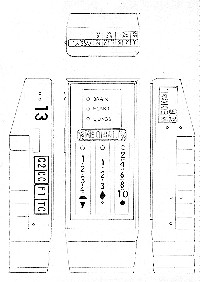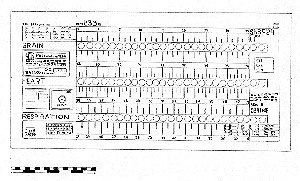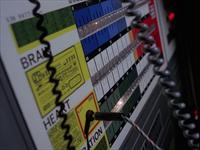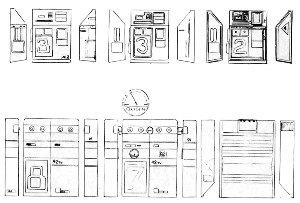I have sketched some of the less well-known props and models in the series. You don't see much of them on screen but I like the look of them, and drawings show details you cannot see in photographs. These sketches aren't works of art, or technical blueprints, but they were drawn with reference to the original props and models. In addition to my poor draughtsmanship the scans of photocopies don't give great quality! They are all copyright Martin Willey.
|
This Geiger counter is seen prominently in the opening scenes of Breakaway. Rather than a conventional needle dial (or LCD digital counter), the counter uses an array of lights. These must be intended to give a clear simple reading visible even in the intense darkness of a lunar night and with poor visibility through an astronaut's visor. Perhaps a more accurate reading is transmitted to the monitoring depot or recorded for later downloading.
This prop is redressed as a medical monitor for with legends reading "Brain", "Heart" and "Lungs". These titles are meaningless- what are they measuring? Brain waves, heart beat, lung capacity? An alternative explanation is that this is still a Geiger counter, and the text are switches to represent different areas of contamination (is their breath radioactive? Press "Lungs" and breathalyse them!) It can be glimpsed in Mark Of Archanon (alongside the Archanon power unit). |
 |
|
This Darian ray gun was also used by Vindrus from the antimatter planet Sunim. I think we have to ignore the difficult problem of how two different civilisations that exist in different dimensions happened to use the same design of weapon! The dial at the bottom of the handle is probably an intensity setting, from mild stun to lethal beam. The beam is generated along the heavy metal antenna, encased in protective perspex. Precise aiming would be difficult; perhaps the weapon has an infra-red sensor and lens in the end of the perspex case to automatically direct the beam to the target. |
 |
| A medical panel from Year Two. There were two of these panels, either mounted on the wall behind a care unit bed or in a free-standing trolley. The three lines of bulbs provide an uncomplicated and very visible way of showing vital signs, although the flashing lights might be distracting to an ill patient. They are not very helpful for detecting arrhythmias, for which you need to see the wave forms (for an electrocardiogram -ECG- there will routinely be twelve signals, each from electrodes attached to the arms, legs and chest of the patient). |  
|
| Maya's scanner is, in close-up, clearly just a hand held camera flash. The reflective metal petals fan out into a cone, but the bulb is replaced with a metal "antenna". There were at least two different props, identical apart from the letraset markings on the back. |  |
|
The desks from Main Mission were modified for Year Two but are still basically the same wooden desks. The additions were a top assembly including a screen, and a heavy weight stand, both giving the desk are more substantial feel. The drawing show measurements from an actual desk. The desks are 4 foot wide by 2 foot deep and 8 inches high (the screen assembly is an additional 7.3 inches on top). The stands are 3 foot 2 inches wide by 1 foot 4 inches deep and 2 foot 2 inches high. |
|
| Spacesuit packs; Year One version, Year Two version and Swift (1996) version. |  |
|
The Eagle cockpit is one of the best examples of production design in the series, practical, colourful and interesting. The two seats are set in a sunken section with the gangplank between them. The door to the main hull of the ship is decorated with the Eagle's number, although for the first episodes of the series it was always a 6. The square ventilation panels either side are bathroom soap racks.
Along the sides are various computer panels. The side computer panels were unchanged until The Mark Of Archanon when new panels included "Oxygen" and "Manual/Remote" on the port (pilot) side and "Engine Ignition" (or "Auxiliary- Engines On/Off") on the starboard (copilot) side. The panels were then shuffled as required through the series. In Devils Planet, a "Laser Control" panel appeared on the starboard. In The Immunity Syndrome "Backup System", "Standby System" and "Laser Control" panels were used on the starboard side. The displays in front of the pilots are rarely seen, but include a TV monitor (in colour for Breakaway, black and white for all subsequent episodes). An early addition was the laser button seen in Black Sun, which in Earthbound became the vacuum chamber controls. Again the design of the panel changed in Year 2, with a central extension sometimes added with additional screens. The forward viewports were only represented by a SFX prop (only the left one is ever seen). In Year Two starting in A B Chrysalis a new screen also appears. In these drawings I have positioned the screen slightly below the viewports (there is not enough room between them). Both the screen and viewport instruments were photographs of real aircraft instruments (from a Sperry catalogue). |

|
Copyright Martin Willey